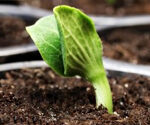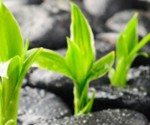SILVER NANOPARTICLES IN SEWAGE SLUDGE HARMFUL TO SOIL MICROORGANISMS
SILVER NANOPARTICLES IN SEWAGE SLUDGE HARMFUL TO SOIL MICROORGANISMS
Recent research has found that silver nanoparticles in sewage sludge, which is used on agricultural land as a fertiliser, can be toxic to soil microorganisms. The researchers calculated that a maximum of 30mg of silver nanoparticles per kilogram of sludge can be applied to land before harm occurs, based on typical application rates in Germany of five tons per hectare of farmland every three years.
Silver nanoparticles’ antibacterial properties mean that they are widely used in a range of materials and consumer products, including plastics, textiles, surface coatings on buildings and cosmetics. Their use is increasing and they are therefore more likely to be released to the environment where they may have damaging effects on ecologically-important bacteria and other living organisms.

There is concern that silver nanoparticles contained in waste material or water may not be removed during processing, as treatment centres are typically not designed to remove nanoparticles. Sewage sludge (the output from wastewater treatment plants) may therefore contain silver nanoparticles and in many countries, sewage sludge is dried and applied as fertiliser on agricultural land. In Germany, for example, about 30% of the 2 million tonnes of dry sewage sludge solids collected from wastewater treatment plants is used to fertilise farmland.
In this study, the researchers investigated the effects of silver nanoparticles incorporated in sewage sludge on soil microorganisms. They first explored the effects of the silver nanoparticles when they were applied in pure form, without being mixed with sewage sludge, to soil microbial communities. It was found that key bacteria that are important to the natural nitrogen cycle were increasingly inhibited over 28 days of testing. The overall size of microbe populations, in terms of biomass, decreased over the 28 days.

They then assessed the nanoparticles’ effects over the longer-term and when incorporated in sewage sludge in laboratory tests. The sludge was processed in a laboratory treatment plant before application. The researchers compared the effects of the silver nanoparticles with those of silver nitrate, a source of silver ions, as silver has previously been identified as toxic to microorganisms when it is not in nanoparticle form.
Over 90% of silver nanoparticles and almost all of the silver ions were absorbed onto the sewage sludge, implying the sewage treatment process did not remove the majority of the nanoparticles or ions. When the contaminated sludge was tested on soil samples over 180 days, the researchers saw similar effects as those that had occurred in the earlier 28 day tests with pure silver nanoparticles. The soil microorganisms were similarly inhibited – by both the silver nanoparticles and the silver ions – at 100 days after application.
At concentrations that would be relevant for actual applications of sewage sludge in Germany, the researchers found that the predicted no-effect concentration (PNEC) (the highest concentration below which no harmful effects are expected to occur) of silver nanoparticles in soil was 0.05 mg/kg dry soil. This is equivalent to a maximum amount of 30 mg/kg dry sludge for each application, based on the average application in Germany of five tons per hectare every three years.
The predicted environmental concentration (PEC) of silver nanoparticles in soil treated with sewage sludge is calculated to be 0.0015 mg/kg dry soil in Europe. With an estimated annual increase of 0.001 mg/kg dry soil, the researchers suggest the PNEC of silver nanoparticles could be exceeded in 50 years. Silver nanoparticles are not very mobile in the soil and with repeated sludge applications containing silver nanoparticles they are likely to accumulate in soil and be a source of bioavailable silver.
Source: Schlich, K., Klawonn, T., Terytze, K., Hund-Rinke, K. (2013) Hazard assessment of a silver nanoparticle in soil applied via sewage sludge. Environmental Sciences Europe. 25: 17. DOI:10.1186/2190-4715-25-17. This study is free to view at: www.enveurope.com/content/25/1/17

